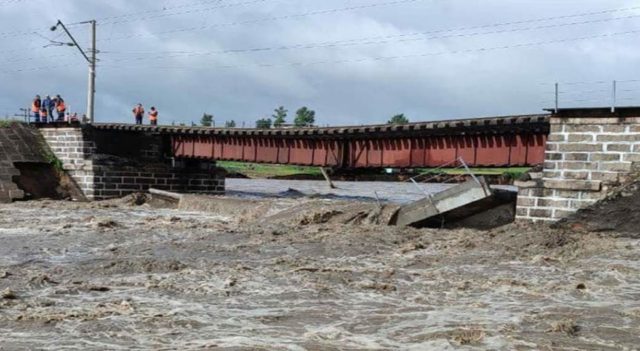
Putin’s Response to Bridge Collapse Highlights Infrastructure and Political Problems
Publication: Eurasia Daily Monitor Volume: 18 Issue: 123
By:

The collapse of a single short river crossing on the Trans-Siberian Railroad 300 kilometers from Chita, in late July, and President Vladimir Putin’s immediate decision to convene a meeting of the Russian Security Council to decide how to correct the situation highlight both the serious shortcomings of Russia’s transportation infrastructure and the dangerous hyper-centralization of decision-making concerning even the smallest of problems. As a result, a minor predicament like the one involving this bridge threatens to grow into something much larger, undercutting Russia’s ability to move goods and people internally as well as the country’s capacity to serve as a transit route for China and other Asian states to and from Europe. And because the Putinist system remains so centralized, Moscow has no choice, at least in the short term, but to involve itself with what in most countries would be considered peripheral issues left to local authorities. But that top–down bureaucratic approach often gives the impression of correcting the situation rather than actually doing so (Vzglyad, July 24).
Last month, serious flooding in the Trans-Baikal region washed away a 25-meter-long bridge, temporarily stopping all rail movements in both directions. Central authorities in Moscow said reconstruction efforts had allowed the railroad to come back to about 50 percent capacity in three days and 100 percent in five, but railway officials admitted the real date for a full recovery is still several weeks away. As a result, Russian trains are unable to meet either the demands of the local population or the contracts Russia has with China, South Korea and other countries. Concerns are, thus, growing in East Asian capitals about Moscow’s ability to handle this traffic, and international shippers are increasingly considering alternative routes through Central Asia by land or by sea through the Suez Canal or the Northern Sea Route (Logirus.ru, July 29 [1] [2], July 30; i38.ru, Kadara.ru, July 31; 360tv.ru, August 3).
Those burgeoning anxieties among Asian logistics firms have mixed with multiple other serious concerns: growing shortages in the Russian Far East; the blockage on the Trans-Siberian Railroad rapidly disrupting service on other lines elsewhere in Russia when the rolling stocks did not reach their destinations; and, likely, the fact that August 1 is the official holiday of railway workers in the Russian Federation and, thus, would have been certain to attract more media attention to the collapsed bridge than might otherwise have been the case. Consequently, Putin convened the Russian Security Council to consider how to respond. The meeting took a series of entirely predictable steps. Several senior railway managers were fired; Moscow promised to come up with more funds to expand the railways, adding new tunnels in the Transbaikal that will allow for two-track rather than single-track movement; and the government recommitted to expanding the Baikal–Amur Mainland (BAM) railway so as to bypass some of the problems of the aging Trans-Siberian route (Vgudok.com, July 30; Mashnews.ru, August 1).
Perhaps more importantly, Russian Prime Minister Mikhail Mishustin said he had dispatched repair equipment from other parts of Russia. Whereas, the defense ministry reported it had its soldiers throw up an emergency bridge nearby, although it is unclear whether that span could carry heavily loaded trains (Vgudok.com, July 23; Vesti-omsk.ru, August 2).
And of course, Putin’s Security Council ordered an investigation to determine whether the bridge failure was ultimately the result of a natural disaster, aging infrastructure or human error. According to some reports, those involved in this process are already saying that “the consequences may be extremely serious,” equivalent to the blockage of the Suez Canal last year or the Bosporus Strait in earlier times (Vostok.today, July 23). Such fears and findings are likely justified in the Russian case. In 2020, a similar bridge disaster in Murmansk Oblast blocked the movement of food to local populations and coal and oil abroad, although the impact on foreign trade then was smaller than might be the case due to any problems involving the Trans-Siberian Railroad (Severpost.ru, August 3).
Aging infrastructure is creating problems in many countries, and political leaders often exploit these to push their agendas as well as to signal to their populations, businesses and other countries that rely on their networks that the authorities are in charge and can easily and quickly solve any problems that arise. Putin is no exception. But correcting infrastructure problems is seldom something that can be done overnight—and that is especially true on the Trans-Siberian railway, where a new tunnel, opened two days ago to much fanfare, had in fact taken seven years to build. Preventing more disasters like the bridge outage will also require much time (Up74.ru, July 30; Smotrim.ru, August 2). In another and critical way, however, Putin finds himself in a different position than the leaders of most other countries. And that dissimilarity is likely to make it far more difficult for Russia to address its problems on the rails and elsewhere.
In most countries, maintenance of infrastructure is addressed locally or regionally, with the central government providing money but distributing it to business or local structures that already exist and are ready and able to correct problems. Indeed, they presumably know far more about the problems of local infrastructure than do those at the center. But in his drive to “optimize” the state so as to have more money for his military and security plans, the current Kremlin leader has destroyed even that relatively limited capacity that grew in Soviet times. As a result, and not only because of Chinese concerns, Putin has to take a hands-on approach to even the smallest of disasters lest they metastasize into bigger ones.



